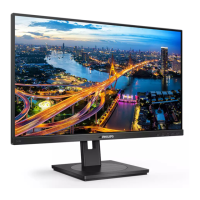
Do you have a question about the Philips 243B1 and is the answer not in the manual?
| Screen Size | 23.8 inches |
|---|---|
| Panel Type | IPS |
| Aspect Ratio | 16:9 |
| Brightness | 250 cd/m² |
| Refresh Rate | 75 Hz |
| Response Time | 4 ms (GtG) |
| Ports | HDMI, DisplayPort, VGA, USB-C, USB 3.2 |
| VESA Mount | 100 x 100 mm |
| Pixel Density | 93 PPI |
| Contrast Ratio | 1000:1 |
| Viewing Angle | 178° (H) / 178° (V) |
| Flicker-free | Yes |
| Picture Enhancement | SmartImage |
| Display Colors | 16.7 million |
| LowBlue Mode | Yes |
| sRGB | Yes |
| Resolution | 1920 x 1080 |
| Built-in Speakers | Yes |
| Backlight Type | W-LED |
| Effective Viewing Area | 527.04 x 296.46 mm |
| Scanning Frequency | 30 - 83 kHz (H) / 56 - 76 Hz (V) |
| USB | USB 3.2 |
| Audio In/Out | Audio out |
| Power Supply | 100-240 V, 50-60 Hz |
| Power LED Indicator | Operation - White |
| Dimensions | 540 x 509 x 216 mm (with stand), 540 x 325 x 51 mm (without stand) |
Guidelines for safe operation, handling, and upkeep of the monitor to prevent damage or hazards.
Explanation of icons, symbols, and conventions used throughout the user manual for clarity.
Instructions on how to properly dispose of the monitor and its packaging according to environmental regulations.
Details on unboxing, identifying package contents, and assembling the monitor stand.
Step-by-step instructions for connecting the monitor to your computer using various cables.
Procedure for installing necessary drivers for USB-C functionality and RJ45 connection.
Information on USB port functionality, including sleep mode behavior and charging capabilities.
Description of control buttons and navigating the On-Screen Display (OSD) menu for adjustments.
Overview of the On-Screen Display menu options for adjusting various monitor settings.
Details on adjusting the monitor's tilt, swivel, height, and pivot for ergonomic positioning.
Instructions for detaching the monitor stand to prepare for VESA wall mount installation.
Explanation of SmartImage presets for optimizing display based on content type.
Details on SmartContrast for dynamic contrast optimization and visual clarity enhancement.
Explanation of Adaptive Sync for smooth, tear-free gaming by synchronizing GPU and monitor refresh rates.
Lists compatible graphics cards and operating systems for Adaptive Sync functionality.
Explanation of PowerSensor technology for automatic power saving based on user presence detection.
Guide on default settings, custom adjustments, and fine-tuning PowerSensor detection.
Instructions for setting up multi-monitor connections using DisplayPort Multi-Stream transport.
Details on daisy-chaining displays via USB-C, including compatible resolutions and number of monitors.
Recommendations for lighting, working habits, and posture to reduce eye strain and fatigue.
Highlights monitor features like anti-glare, flicker-free, LowBlue, and EasyRead modes for eye comfort.
Detailed specifications for monitor panel type, resolution, refresh rates, colors, and enhancement features.
Information on input/output ports, USB connectivity, USB-C power delivery, and network interfaces.
Specifications related to power consumption in different modes and physical dimensions of the monitor.
Details on operating temperature, humidity, atmospheric pressure, and environmental compliance.
Information on maximum and recommended resolutions, including horizontal and vertical frequencies.
Explanation of VESA DPM compliance for automatic power reduction when the monitor is not in use.
Philips' policy on acceptable levels of pixel and sub-pixel defects for warranty claims.
Information on obtaining support, warranty coverage, and extended warranty options.
Solutions for common issues like no picture, incorrect image centering, and flickering.
Answers to frequently asked questions regarding resolution, drivers, OSD settings, and screen care.